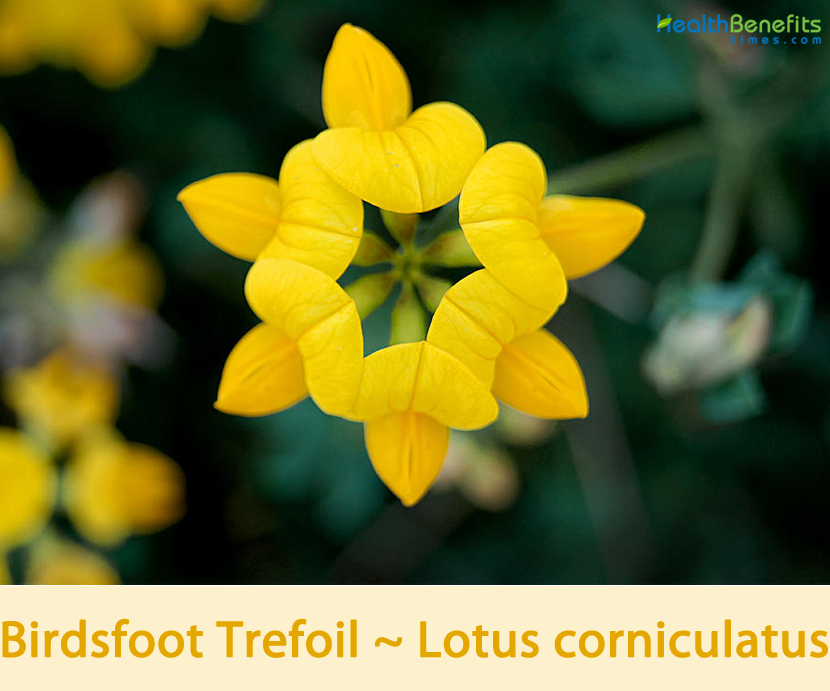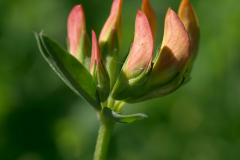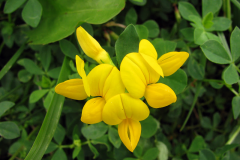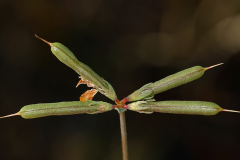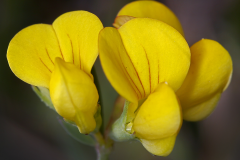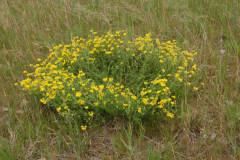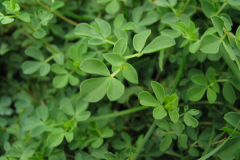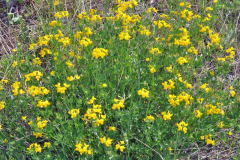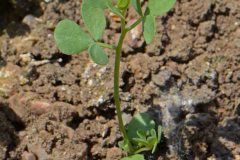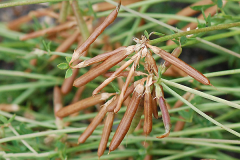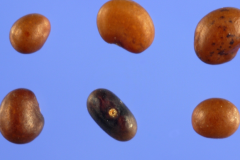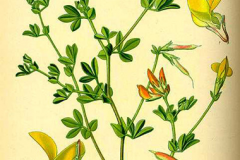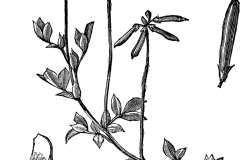Genus name comes from the classical Greek name lotos applied to many plants including clover, bird foot trefoil and fenugreek. The specific epithet corniculatus means having small horns or spurs. The common name bird’s-foot comes from the similarities in appearance between the clusters of long, narrow seed pods and a bird’s foot. The term trefoil refers to the three leaflets that make up the compound leaves of this plant. It is known as Bird’s-foot-trefoil as it produces seedpods arranged in a bird’s foot pattern. It is often used as forage and is widely used as food for livestock due to its non-bloating properties. The plant is harvested from the wild for local use as a medicine, dye and possibly food. It is often grown as a green manure and soil improver. It has become widespread outside of its native range due to purposeful planting for erosion control and as forage for livestock. It is now considered an exotic invasive weed in parts of the United States, Canada, and Australia.
Birdsfoot Trefoil Facts
| Birdsfoot Trefoil Quick Facts | |
|---|---|
| Name: | Birdsfoot Trefoil |
| Scientific Name: | Lotus corniculatus |
| Origin | Northern and eastern Africa, most of Europe, western Asia , the Indian sub-continent and eastern Asia |
| Colors | Pods turn light brown to black when mature |
| Shapes | Narrowly cylindrical pods that are 15-30 mm long and 2-3 mm wide borne at right angles to the top of the peduncle |
| Health benefits | Support for anxiety, insomnia, exhaustion, heart palpitations, persistent and chronic nervousness, depression, digestion, fever and also cancer |
| Name | Birdsfoot Trefoil |
|---|---|
| Scientific Name | Lotus corniculatus |
| Native | Northern and eastern Africa (i.e. northern Algeria, Morocco, Tunisia, Ethiopia, Sudan, Kenya and Tanzania), most of Europe, western Asia (i.e. Afghanistan, Cyprus, Iran, Iraq, Turkey, Armenia, Azerbaijan, Georgia, southern Russia, Kazakhstan, Tajikistan and Turkmenistan), the Indian sub-continent (i.e. India, Nepal and Pakistan) and eastern Asia (i.e. Mongolia, China, Japan, Korea and Taiwan). It has been introduced to many areas including Australia, North and South America. |
| Common Names | Bird foot deer vetch, bird’s foot lotus, bird’s foot trefoil, broadleaf birdsfoot trefoil, cat’s clover, common bird’s-foot trefoil, crow toes, eggs-and-bacon, ground honeysuckle, Dutchman’s clogs, lady’s slippers, granny’s toenails, Devil’s fingers, trefoil, upright trefoil, common lotus, broad-leaved trefoil, common trefoil, common birds foot, Bloomfell, Garden Birds foot Trefoil |
| Name in Other Languages | lbanian: Thuepula, thuepulë Arabic: Lutas yabaniun (لوطس ياباني), alluwats alyabaniu (اللوطس الياباني) Aragonese: Cuernecillo, guixa rastrera, trebol de cuernos Armenian: Ekhdzherarvuit, Yeghjerarrvuyt yeghjravor (Եղջերառվույտ եղջրավոր) Azerbaijani: Buinuzlu Gurdotu, Gafgaz Gurdotu Basque: Mendiko uso-belar, usobelarra Bulgarian: obiknoven zvezdan (обикновен звездан), zvezdan rogčeta (звездан рогчест) Catalan: Lot corniculat, corona de rei Chinese: Bai mai gen (百脉根) Cornish: Pys an gath Croatian: Roščićava djetelina Czech: Stírovník růžkatý Danish: Serradel, Almindelig kællingetand Dutch: Rolklaver, Gewone rolklaver, Tôchklaver, Gewone rolklaver en rechte rolklaver, gehoornde rolklaver English: Bird’s-foot trefoil, birdsfoot trefoil, Common birdsfoot-trefoil, Garden bird’s-foot-trefoil, Birdfoot deervetch, Bloomfell, Cat’s clover, Common bird’s-foot trefoil, Crowtoes, Garden birdsfoot trefoil, Ground honeysuckle, garden deervetch Estonian: Harilik Noiahammas Finnish: Keltamaite French: Lotier corniculé, Lotus corniculé, Lotus des prés, Pied de poule, Serradelle, Trèfle cornu, Cornette, Cube, patte d’oiseau, cornette, lotier commun, lotier des prés Galician: Corniños German: Gewöhnlicher Hornklee, Hornklee, Hornschotenklee, Schotenklee, Common Birds-foot Trefoil, Gemeiner Hornklee, gehörnter Schotenklee, gewöhnlicher Schotenklee, Wiesenhornklee, Wiesenschotenklee Georgian: Kurdglisprchkhila, Kurdlis Prukhila Greek: Lotós (λωτός) Hebrew: Lotus makrin, lutus mkrin (לוֹטוּס מַקְרִין) Hungarian: Szarvaskerep Irish: Crobh éin Italian: Ginestrina, Ginestrino, Loto, Mullaghera, Ginestrino commune, trifoglio giallo Japanese: Miyako gusa (ミヤコグサ), Seiyoumiyakogusa (セイヨウミヤコグサ) Korean: Beol no raeng I (벌노랭이), seo yang beol no rang I (서양벌노랑이) Latvian: Ragaine Vanagnadzini Lithuanian: Paprastasis Garzdenis Mongolian: Ebert Khoshoontzor North Frisian: Henk an höön Norwegian: Tiriltunge, Mariae guld-tøfler Occitan: Boulumague, cap-arroùs, caprós, embriagacabra, lotgèr, ludjé, pinausèl, pè d’oset Persian: آهوماش زرد Polish: Komonica zwyczajna, komonica rożkowa Portuguese: Cornichão, Serradela, loto Romanian: Ghizdei Marunt Russian: Lyadvenetz Baltiiski, Lyadvenetz Kavkazski, Lyadvenetz Komarova, Lyadvenetz Krymski, Lyadvenetz Olgi, Lyadvenetz Polevoi, Lyadvenetz Rogatyi (Лядвенец рогатый), Lyadvenetz Ruprekhta, Lyadvenetz Somnitelnyi, Lyadvenetz Zhigulevski Serbian: Zvezdan (Звездан), žuti zvezdan (жути звездан), obična smiljkita (обична смиљкита) Slovak: Ladenec rožkatý, ľadenec rožkatý pravý Slovene: Navadna nokota Spanish: Cuernecillo, Cuernecillo del campo, Loto de los prados, Serradella, Trébol a cuernitos, Trébol pata de pájaro, Loto Corniculado, Navadna nokota, cornajuelos, corona de rey, lotera, trébol Amarillo, trébol de vainas cornudas, trébol de cuernitos Swedish: Käringgigel, Käringtand Turkish: Gazelboynuzu Ukrainian: Lyadvenetsʹ rohatyy (Лядвенець рогатий), lyadvenetsʹ polʹovyy (лядвенець польовий), lyadvenetsʹ sumnivnyy (лядвенець сумнівний) Upper Sorbian: Łučny ledźbjenc Welsh: Pysen-y-ceirw |
| Plant Growth Habit | Short to medium-lived, invasive low-growing, slightly-decumbent, herbaceous perennial plant |
| Growing Climates | Pastures and sunny banks of streams, grassy places, moist to dry roadsides, waste places, lawns in the lowland, steppe and montane zones, thickets, scrub, damp meadows, alpine meadows, rocky slopes, ravines, river valleys, abandoned fields, cultivated ground, roadside embankments, slopes of drainage ditches, weedy corners of parks, and miscellaneous waste areas |
| Soil | Can grow on a wide range of soils and does best on soil with a pH ranging from 6.2 to 6.5 or above. It is tolerant of wet acidic soil (pH = 4.5) and has some drought tolerance. Birdsfoot trefoil can withstand some soil salinity |
| Plant Size | 5 to 20 centimeters (2 to 8 inches), occasionally more where supported by other plants |
| Root | Tap rooted and has many lateral roots, mainly in the top 60 cm of soil. The root system can go as deep as 120 cm |
| Stem | Nearly square, erect or sprawling on the ground, branched, either smooth or sparsely hairy, and up to one and a half feet long |
| Leaf | Leaves are alternate and pinnately compound in 5s with 3 leaflets at the tip of the leaf stalk and a pair of leaflets at the base of the stalk where it joins the stem |
| Flowering season | June to September |
| Flower | Flowers are 10 to 18 mm long. Calyxes are glabrous or sparsely hairy with linear to lanceolate teeth that roughly equal the length of the tube. Corollas are yellow, sometimes red-tinged, and 8 to 15 mm long. Corollas consist of five petals each |
| Fruit Shape & Size | Narrowly cylindrical pods that are 15-30 mm long and 2-3 mm wide, brown to almost black, borne at right angles to the top of the peduncle |
| Fruit Color | Pods turn light brown to black when mature |
| Seed | Seeds are very small, olive green to black in color and hard-coated |
| Plant Parts Used | Flowers, root, seed pods |
| Propagation | By seed and by modified stems and rhizomes |
| Varieties |
|
| Season | August to October |
Plant Description
Birdsfoot Trefoil is a short to medium-lived, invasive low-growing, slightly-decumbent, herbaceous perennial plant that normally grows about 5 to 20 centimeters (2 to 8 inches) tall, occasionally more where supported by other plants. It is an extremely variable prostrate or ascending, hairy or hairless perennial herb. The plant is found growing in pastures and sunny banks of streams, grassy places, moist to dry roadsides, waste places, lawns in the lowland, steppe and montane zones, thickets, scrub, damp meadows, alpine meadows, rocky slopes, ravines, river valleys, abandoned fields, cultivated ground, roadside embankments, slopes of drainage ditches, weedy corners of parks, and miscellaneous waste areas. It can grow on a wide range of soils and does best on soil with a pH ranging from 6.2 to 6.5 or above. It is tolerant of wet acidic soil (pH = 4.5) and has some drought tolerance. Bird’s foot trefoil can withstand some soil salinity.
Stem
The stems of L. corniculatus are nearly square, erect or sprawling on the ground, branched, either smooth or sparsely hairy, and up to one and a half feet long. Numerous stems arise from a basal, well-developed crown with branches arising from leaf axils.
Leaves
Leaves are alternate and pinnately compound in 5s with 3 leaflets at the tip of the leaf stalk and a pair of leaflets at the base of the stalk where it joins the stem. The tip leaflets resemble a 3-leaf clover but the leaflets are at bit more elongated, up to 0.5 in. (1.3 cm) long and less than 0.13 in. (0.3 cm) wide, rounded or pointed at the tip, wedge-shaped at the base and lack stalks. The pair of leaflets at the base is slightly smaller and more egg-shaped, pointed at the tip and rounded at the base, and resembles leafy stipules. All leaflets are stalk less, toothless and mostly hairless.
Flower
Flowers are arranged in axillary umbels in groups of two to eight at the tip of a long, naked stalk arising from leaf axils along branching stems. Peduncles are stout and 3 to 10 cm long. Flowers are 10 to 18 mm long. Calyxes are glabrous or sparsely hairy with linear to lanceolate teeth that roughly equal the length of the tube. Corollas are yellow, sometimes red-tinged, and 8 to 15 mm long. Corollas consist of five petals each; however, the lower two petals are united to form a keel. Flowers may turn orange, sometimes streaked red. Flowering normally takes place in between June to September.
Fruit
Fertile flowers are followed by narrowly cylindrical pods that are 15-30 mm long and 2-3 mm wide, brown to almost black, borne at right angles to the top of the peduncle (hence ‘bird’s-foot’ trefoil as the common name). They consist up to 49 seeds and have a persistent style at the apex. Seeds are irregularly rounded, somewhat flattened, 1.3-1.5 mm long, variable in color at maturity, olive to brownish to almost black, frequently speckled and shiny. Seeds are ejected from the pods as the pods rupture at maturity, averaging 375,000 seeds per pound.
Traditional uses and benefits of Birdsfoot Trefoil
- The flowers are antispasmodic, cardio tonic and sedative.
- The root is carminative, febrifuge, restorative and tonic.
- The plant is used externally as a local anti-inflammatory compress in all cases of skin inflammation.
- In the traditional medicine of the Sannio region of Italy, the diluted infusions were used for anxiety, insomnia, and exhaustion.
- The plants are recommended for the treatment of problems such as heart palpitations, persistent and chronic nervousness, long term depression, and sleep disorders such as insomnia.
- When used in small amounts, hydrogen cyanide helps to promote respiration as well as enhance digestion.
- In addition, it is also said to be helpful in treating cancer.
- The seeds can be nibbled and it has been used medicinally to remove gas and reduce fever.
- Herbal tea has antipyretic, hypoglycemic, antispasmodic, cardio tonic, anthelmintic, anti-inflammatory, healing, soothing and gastric properties.
- It is recommended for the treatment of tachycardia, persistent and chronic anxiety, long-term depression and insomnia.
- It is applied externally to the skin in the form of poultice against skin’s inflammations.
Other Facts
- An orange-yellow dye is obtained from the flowers.
- It is a useful green manure plant, fixing atmospheric nitrogen.
- It is difficult to see this plant as a useful green manure; it is fairly slow growing with us and does not produce much bulk.
- It is used in agriculture as a forage plant, grown for pasture, hay, and silage.
- It is high quality forage that does not cause bloat in ruminants.
- It may be used as an alternative to alfalfa in poor soils.
- It can also prevent soil erosion and provide a good habitat for wildlife.
- It has been commonly planted along roadsides for erosion control or pastures for forage and then spreads into natural areas.
- It also provides food for elk, deer, Canadian geese (Bush, 2002) sheep, voles, and rabbits.
- The plant was also used to dye fabrics during the colonial period.
Precautions
- All parts of the plant are poisonous, containing cyanogenic glycosides (hydrogen cyanide).
- In small quantities, hydrogen cyanide has been shown to stimulate respiration and improve digestion, it is also claimed to be of benefit in the treatment of cancer.
- In excess, however, it can cause respiratory failure and even death.
- They are completely innocuous when dried.
Management Info
Physical
To control small infestations of L. corniculatus, dig up plants by roots, making sure to remove all root fragments. For larger infestations, frequent mowing (more than once every 3 weeks) at a height of less than two inches for several years helps to control the plant but may set back native plants. Controlled burns of L. corniculatus are not recommended because they increase seed germination and promote seedling establishment.
Chemical
Lotus corniculatus can be effectively controlled with general use herbicides such as: clopyralid, glyphosate, and triclopyr. Jones & Turkington report that morfamquat, ioxynil plus mecoprop, 2; 4-D-mecoprop, dichlorprop, fenoprop, and dicamba are effective herbicide treatments on L. corniculatus, while MCPA-salt, 2, 4-D-amine and ester has no effect. Acumen and basagran MCPB are considered very toxic herbicide treatments for L. corniculatus seedlings. Considerable damage to seedlings was caused by: brasoran, gesagard, and opogard; EPTC was considered an ineffective treatment. L. corniculatus showed no response to carbofuran or benomyl. Spot spraying affected areas, (after re-greening from a burn or mowing), with clopyralid + surfactant + dye. (This selective herbicide also affects native plants of the sunflower and pea families.)
References:
https://www.itis.gov/servlet/SingleRpt/SingleRpt?search_topic=TSN&search_value=26362#null
https://npgsweb.ars-grin.gov/gringlobal/taxon/taxonomydetail?id=300317
https://pfaf.org/user/Plant.aspx?LatinName=Lotus+corniculatus
https://www.cabi.org/isc/datasheet/31365
https://en.wikipedia.org/wiki/Lotus_corniculatus
https://www.feedipedia.org/node/280
https://gobotany.nativeplanttrust.org/species/lotus/corniculatus/
https://accs.uaa.alaska.edu/wp-content/uploads/Lotus_corniculatus_BIO_LOCO6.pdf
https://apg.pir.sa.gov.au/gringlobal/taxonomydetail.aspx?id=300317
https://gd.eppo.int/taxon/LOTCO
https://plants.usda.gov/home/plantProfile?symbol=LOCO6
https://www.flowersofindia.net/catalog/slides/Common%20Birdsfoot%20Trefoil.html


